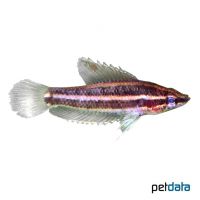Deissner's Liquorice Gourami (Parosphromenus deissneri)
| Deissner's Liquorice Gourami Parosphromenus deissneri | |
|---|---|
| Name | Deissner's Liquorice Gourami |
| Name Lat. | Parosphromenus deissneri |
| Family | Gouramies |
| Family lat. | Osphronemidae |
| Order | Labyrinth Fishes |
| Order lat. | Anabantiformes |
| Origin | Sumatra |
| Habitat | Streams, ponds |
| Diet | Carnivore |
| pH | 4.0-6.5 |
| Behavior | Peaceful |
| Keeping | Pair |
| Care Level | Difficult |
| Reproduction | Cave spawner |
| Breeding | Difficult |
| Life Span | 3-5 years |
| Protection | No |
| Metric Units | |
| Size | 4 cm |
| Temperature | 22-28 °C |
| Hardness | 1-5 °dH |
| Aquarium | ~ 50 l |
| US Units | |
| Size | 1.6" |
| Temperature | 72-82 °F |
| Hardness | 18-90 ppm |
| Aquarium | ~ 15 gal |
Distribution and habitat
The distribution area of the Deissner's magnificent gourami is exclusively (endemic) the island of Bangka northeast of Sumatra (Indonesia). They live in shady, slow-flowing streams and in pools with dense underwater vegetation and dead wood.
Maintenance
The aquarium should have dense planting with many hiding places (roots, caves). A dark substrate with peat and foliage (sea almond leaves), shaded light (floating plants) and very soft, slightly acidic water is ideal.
No ammonia, ammonium and nitrite should be detectable, the nitrate value should not exceed 100 mg/l. To ensure the water quality and oxygen content, a filter and heater adapted to the aquarium size is required, as well as lighting for the species-appropriate day-night rhythm of the animals.
Diet
In nature they feed mainly on small crustaceans, insects and insect larvae. The food supply consists of live and frozen food. For a balanced diet, feed once daily with microworms, cyclops, moina, daphnia, artemia, mosquito larvae, etc. (live or frozen). Dry food and freeze-dried food should not be the main component of the food supply
It is recommended to feed small portions several times a day. Only feed as much as will be eaten within a few minutes. A regular and varied diet promotes health and prevents deficiency symptoms.
Behaviour and compatibility
They are peaceful and shy fish that should be kept in pairs. A socialization with other small and peaceful fish is well possible, but better is the attitude in a species tank.
In principle, only mutually compatible fish species with similar requirements to the water condition and water temperature may be socialized.
Sex dimorphism
The males have blue and red stripes in the dorsal fin are more intensely colored at spawning time. The females appear somewhat more plump at spawning time.
Reproduction and breeding
They build a loose foam nest in a cave (flowerpot, tube) and the male takes over the brood care. The eggs ejected during the numerous matings (embraces), a total of 40-100 pieces, are collected by the male and placed in the nest. The larvae hatch after 24-36 hours and swim freely after 3-6 days.
The fry must be fed several times a day with special rearing food (Artemia nauplii). In a community tank breeding is hardly possible, because the spawn is easy prey.
Important
They have an additional respiratory organ, the so-called labyrinth (suprabranchial organ) with which they breathe atmospheric air and can suffocate if this is not possible. The air temperature in the breathing area must not be below the water temperature!
The foliage (sea almond tree, oak, etc.) enriches the water with humic substances, naturally lowers the pH and, when rotting, promotes the development of microorganisms, which are a valuable secondary food source. Only in perfect water conditions they show their magnificent coloration
The well-being of the fish should be checked regularly. Temperature should be checked daily, pH, hardness and nitrate levels at least every 14 days. A regular partial water change is recommended, even if the pollutant load has not yet reached the upper limit. Sudden changes in water quality should be avoided. Newly introduced fish must be accustomed slowly to the water in the aquarium.
Further literature can be found in your pet store.
References
Text: petdata; Image: petdata
Source: BMELV (1998): Tierschutzgutachten - Haltung von Zierfischen (Süßwasser); RIEHL & BAENSCH (2006): Aquarien Atlas Bd. 1, Mergus Verlag; ENGELMANN (2005): Zootierhaltung - Tiere in menschlicher Obhut: Fische, Verlag Harri Deutsch
- Gemäß § 21 Abs. 5 Tierschutzgesetz idgF
